From NOKLA to Xiaomi: the evolution of Chinese mobile phones
The world is crazy about Xiaomi, buying Meizu, on which the world is scolding software shells and never ceases to order smartphones from China. Phones became almost the first product that could throw off the curse of the “Made in China” nameplate and turned it, if not into a sign of quality, then at least into a sign: “Wow, not worse than flagships, and cheaper”. But literally in 2006-2007 in Russia one could meet the notorious Nokly and Samson, which sometimes was not enough even for one call. In this post, we’ll pause for a bit and dive into the history of Chinese smartphone construction, and at the same time we’ll find out exactly what Russian users have chosen among Chinese smartphones this summer. Warn immediately - the top is a bit unpredictable.

It may seem that the history of the Chinese "mobilization" began some ten years ago with a fake phone under the NOKLA brand or from those phones with a television receiver and loud squeaky speakers. However, the evolution of mobile communication and the Celestial cell phones of China is as dramatic and interesting as the history of China itself. And now, in 2015, 1.3 billion mobile subscribers were registered in the country, and by the end of 2017, the number of users increased to 1.42 billion. The entire subscriber base needs mobile devices, and sometimes two per person. Of course, this could not but stimulate the development of the mobile phone market in China.
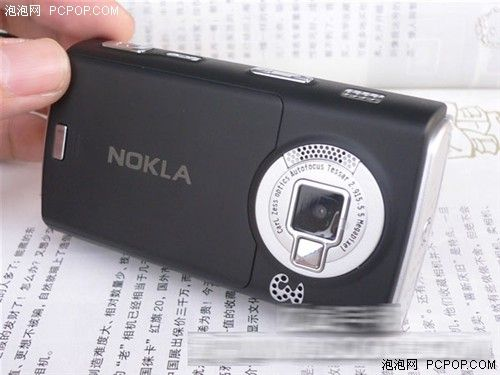
Here it is, the legendary Nokla!
')

Well, at least Sunny ...
Until 2006-2008 in the Chinese market, the “brand” Shanzhai dominated - this is how it is called various Chinese fakes, and not necessarily low-quality ones that simply imitate someone else's brand in terms of design and name. It was Shanzhai that became the main prerequisite for the development of the mobile device market in China. The fact is that these very "non-brand" phones were able to alter the domestic market, winning a share from international companies considering China as a tasty but not sufficiently profitable market. Cooperation with Mediatek, which supplies chips for smartphones, contributed to such a rapid pace of development - in fact, manufacturers could only confuse with design and usability (to make their shell). And they were not shy: phones with flashlights (a classic!), Smartphones in the form of watches, with solar batteries, telephoto lenses, and fake money testers surprised users (however, it was hardly possible to surprise the Chinese).
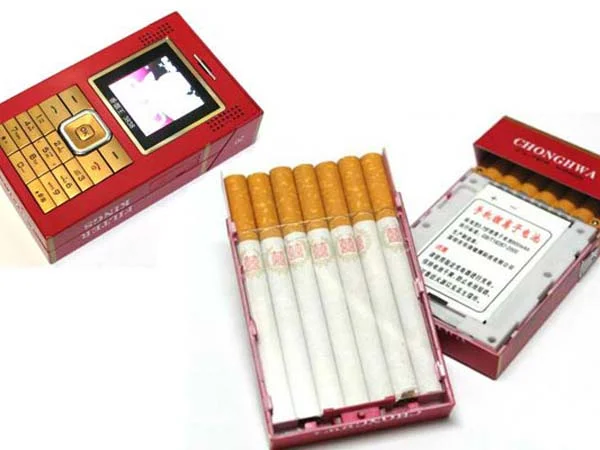
They were also in the form of a Marlboro pack
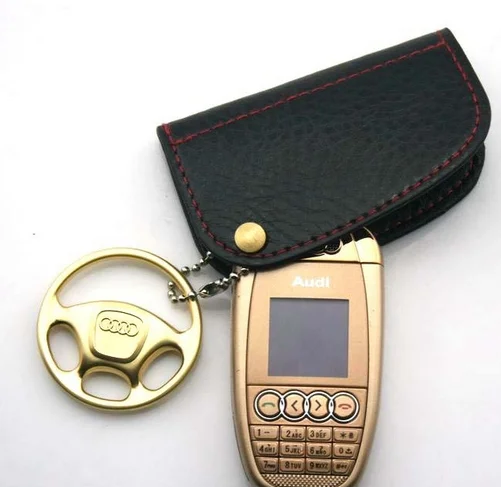
Audi, I, zer gut
At the same time with these “weedy” seedlings from below, the Chinese government from above pursued a policy of patronizing the development of mobile technologies, set industry industry standards, and the local “big three” of manufacturers Datang, Huawei and China Mobile received generous support. In 2007, the government liberalized legislation on the production and sale of mobile phones.
Here we must stop and tell that the Chinese state and business had (and have) far more far-reaching plans than providing their own population with 3G smartphones on board. The fact is that China has developed its third-generation mobile network standard TD-SCDMA as an alternative to two competing international standards, CDMA2000 and W-CDMA. In 2007, the mobile operator China Mobile announced a tender for the creation of a test network of 3G standard TD-SCDMA. The applications for the tender were listed by Nokia and Ericsson, but most of the contract went to Datang Mobile and ZTE, the tasks for the network core went to Huawei.
However, with the advent of 3G, “shandzhaya” began to have technological problems, and the market does not tolerate emptiness - Chinese brands immediately appeared, which began to produce fairly high-quality devices at the level of world leaders, but at lower prices: Xiaomi, Lenovo, Coolpad, “ Oldies »Huawei and ZTE. These brands quickly supplanted local fakes and got ready for a fight with Apple, Samsung and Nokia, the outcome of which became known in 2014: the Chinese overtook the Koreans and Americans. Finns bent themselves. Chinese brands produced one for one model, costing less than 2,000 yuan (at that time - about 12,500 p.), And some less than 1,000 - and thus seized a huge low-income segment of China.
And it was to the leaders of the Chinese production that the understanding simple in its frankness and superficiality came: the phone is not just a cool thing with gadgets, it is primarily a complex intellectual device with three levels of organization: physical (sensors, screens, buttons, cases, battery), platform (operating system and native applications) and the level of external applications (shops, games, services).
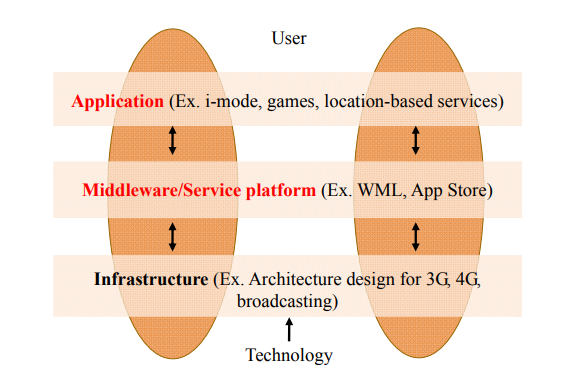
From this point on, the newest history began - those phones that the whole world orders from us on Gearbest . Now in China, more than three hundred manufacturers of smartphones, some of which make presentations no worse than Apple and conquer exhibitions and buyers, most simply produce normal inexpensive smartphones "sit and call on the Internet", a smaller part makes white label (OEM) - produce smartphones that may gain any new name.
By the way, many Russians are quite closely acquainted with Chinese phones and these are not only owners of major brands from the Middle Kingdom, such as Meizu or Xiaomi. Which of you had Highscreen, Oysters, TeXet, Explay, maybe IconBit, Qumo? These are all Chinese smartphones in the hands of enterprising Russian entrepreneurs. And of course, all the Big Three cameramen, and now the damn ones, are inexpensive Chinese “white boxes”. To pay tribute, the devices, starting from the middle price segment, are well assembled, functional and serve faithfully. Although the shoals of translation happen so far.
Why in 2008 there was a technological break in the production of Chinese mobile phones? We think that for Habr's readers there will not even be an intriguing pause here, because everyone remembers - in 2007 Google announced the release of the Android mobile platform. Of course, before that, there were mobile operating systems and development platforms - mainly Symbian and Windows Mobile. But they were closed and quite expensive, which, of course, instantly increased the cost of the device and the entire Chinese mobile system collapsed. Needless to say, Android OS gave chances for development and, most importantly, customization of the shell.
Chinese manufacturers waited for access to the new operating system, but it did not turn into golden Eldorado - rather, it was the ore from which it was necessary to choose precious metal particles. The fact is that almost all Chinese mobiles were equipped with Mediatek chipsets, which once formed the Chinese mobile industry, and by the end of the 2000s, performance was far behind Qualcomm. Because of this, the first smartphones got all the typical illnesses of cheap androids: an overheated and quickly discharging battery, problems with high-resolution touch screens, interface hangs.
The first to overcome these problems was the Huawei U8220, using the Qualcomm performance chipset. The second company that came to the new model was Lenovo, and then Meizu pulled up with its M9 (already Android 2.2).

However, Mediatek also did not silently survive its fiasco, but offered the market powerful mobile processors that manufacturers have adopted due to humane pricing policies against the inhumane Qualcomm. Stamps have multiplied with unrealistic power - many of them we have never heard of, some have found popularity in the CIS, for example, Zoppo.
And it was a real breakthrough: since the summer of 2011, the brands that were to conquer the whole world began to actively expand: Xiaomi, Meizu, OnePlus (Oppo). The flagship parade was opened by Xiaomi Mi 1 with a custom MIUI shell. A super slim Oppo smartphone (which in 2014 turned into a hit One Plus) followed, the parade first closed the Meizu MX4.
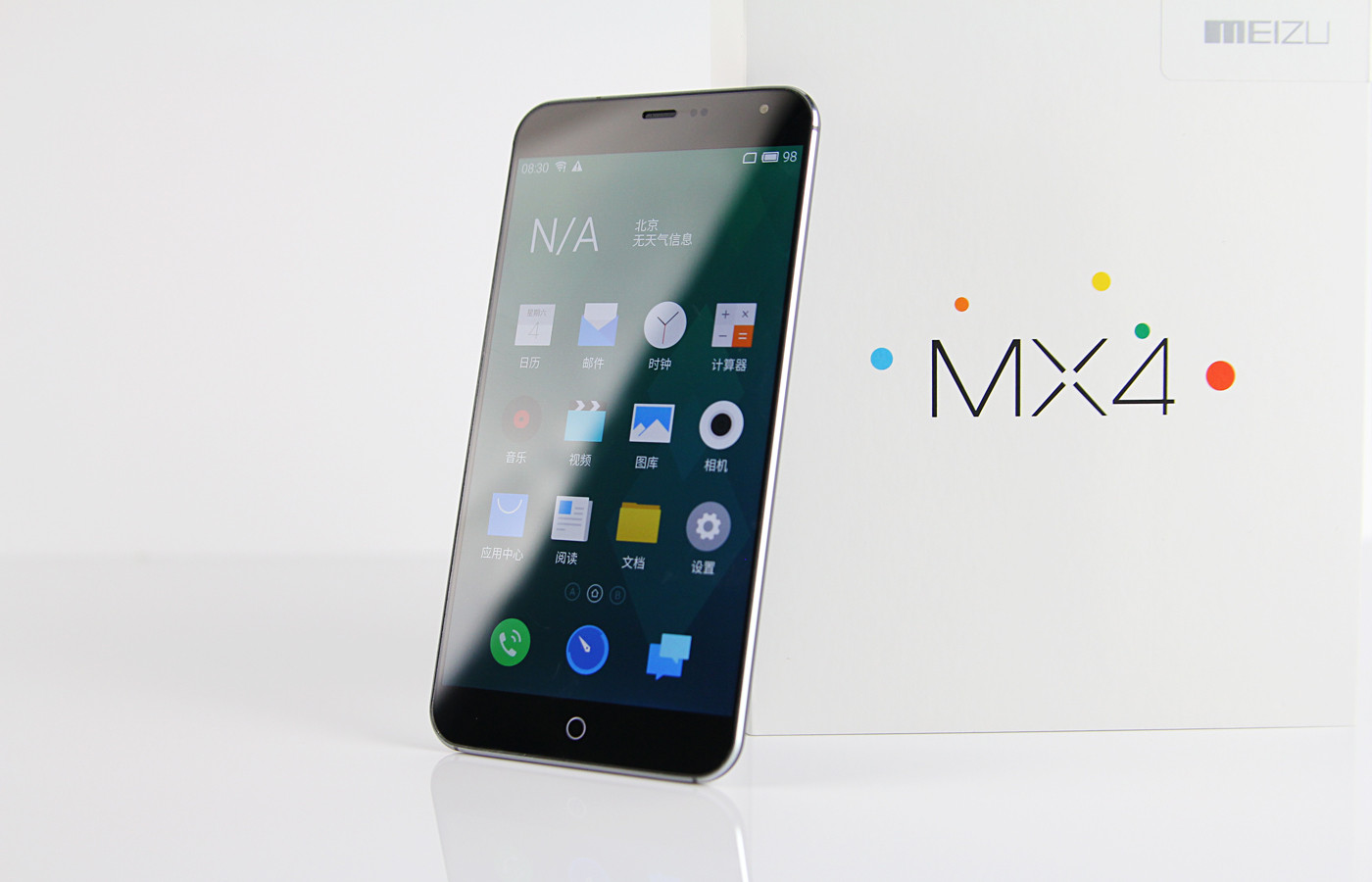
Well, now the main players have obviously stood out, they divide the market, but the market logically shrinks:
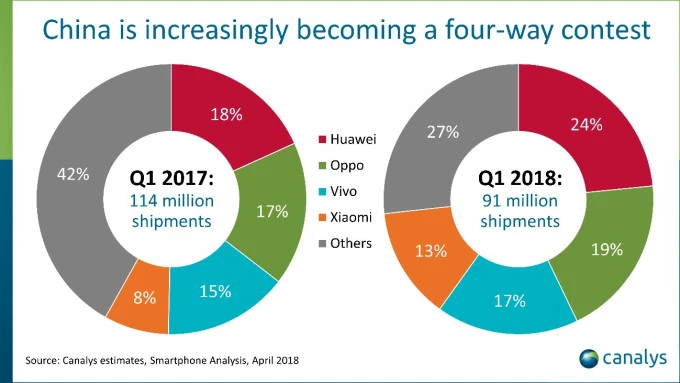
Well, what to buy, except for them? Joke. Of course it is. But the question did not arise in vain - many myths have developed around smartphones from the Middle Kingdom. Let's sort a few main ones.
By the way, see a cool ad for a Chinese ultra durable smartphone. This is an absurd mini-movie:
The Chinese smartphone is no longer a symbol of a fake, it is a symbol of a reliable and inexpensive device with advanced technologies on board. Of course, the myths in the mass consciousness still live. But we all know :)
All summer we shipped smartphoneswith barrels to Russian users and the sample was not sickly in size. So, you can make an honest rating of the most ordered smartphones with Gearbest in the summer of 2018. Several brands hit the top:
So, the top 11 summer of 2018 according to Gearbest customers:
A good and varied top, we like ourselves. Tell us, what is your relationship with Chinese smartphones? Did they deal with them in the early 200s, or only Nokia, only hardcore?

Empire shanzhai
It may seem that the history of the Chinese "mobilization" began some ten years ago with a fake phone under the NOKLA brand or from those phones with a television receiver and loud squeaky speakers. However, the evolution of mobile communication and the Celestial cell phones of China is as dramatic and interesting as the history of China itself. And now, in 2015, 1.3 billion mobile subscribers were registered in the country, and by the end of 2017, the number of users increased to 1.42 billion. The entire subscriber base needs mobile devices, and sometimes two per person. Of course, this could not but stimulate the development of the mobile phone market in China.

Here it is, the legendary Nokla!
')

Well, at least Sunny ...
Until 2006-2008 in the Chinese market, the “brand” Shanzhai dominated - this is how it is called various Chinese fakes, and not necessarily low-quality ones that simply imitate someone else's brand in terms of design and name. It was Shanzhai that became the main prerequisite for the development of the mobile device market in China. The fact is that these very "non-brand" phones were able to alter the domestic market, winning a share from international companies considering China as a tasty but not sufficiently profitable market. Cooperation with Mediatek, which supplies chips for smartphones, contributed to such a rapid pace of development - in fact, manufacturers could only confuse with design and usability (to make their shell). And they were not shy: phones with flashlights (a classic!), Smartphones in the form of watches, with solar batteries, telephoto lenses, and fake money testers surprised users (however, it was hardly possible to surprise the Chinese).

They were also in the form of a Marlboro pack

Audi, I, zer gut
Market found 3G point
At the same time with these “weedy” seedlings from below, the Chinese government from above pursued a policy of patronizing the development of mobile technologies, set industry industry standards, and the local “big three” of manufacturers Datang, Huawei and China Mobile received generous support. In 2007, the government liberalized legislation on the production and sale of mobile phones.
Here we must stop and tell that the Chinese state and business had (and have) far more far-reaching plans than providing their own population with 3G smartphones on board. The fact is that China has developed its third-generation mobile network standard TD-SCDMA as an alternative to two competing international standards, CDMA2000 and W-CDMA. In 2007, the mobile operator China Mobile announced a tender for the creation of a test network of 3G standard TD-SCDMA. The applications for the tender were listed by Nokia and Ericsson, but most of the contract went to Datang Mobile and ZTE, the tasks for the network core went to Huawei.
However, with the advent of 3G, “shandzhaya” began to have technological problems, and the market does not tolerate emptiness - Chinese brands immediately appeared, which began to produce fairly high-quality devices at the level of world leaders, but at lower prices: Xiaomi, Lenovo, Coolpad, “ Oldies »Huawei and ZTE. These brands quickly supplanted local fakes and got ready for a fight with Apple, Samsung and Nokia, the outcome of which became known in 2014: the Chinese overtook the Koreans and Americans. Finns bent themselves. Chinese brands produced one for one model, costing less than 2,000 yuan (at that time - about 12,500 p.), And some less than 1,000 - and thus seized a huge low-income segment of China.
And it was to the leaders of the Chinese production that the understanding simple in its frankness and superficiality came: the phone is not just a cool thing with gadgets, it is primarily a complex intellectual device with three levels of organization: physical (sensors, screens, buttons, cases, battery), platform (operating system and native applications) and the level of external applications (shops, games, services).

From this point on, the newest history began - those phones that the whole world orders from us on Gearbest . Now in China, more than three hundred manufacturers of smartphones, some of which make presentations no worse than Apple and conquer exhibitions and buyers, most simply produce normal inexpensive smartphones "sit and call on the Internet", a smaller part makes white label (OEM) - produce smartphones that may gain any new name.
By the way, many Russians are quite closely acquainted with Chinese phones and these are not only owners of major brands from the Middle Kingdom, such as Meizu or Xiaomi. Which of you had Highscreen, Oysters, TeXet, Explay, maybe IconBit, Qumo? These are all Chinese smartphones in the hands of enterprising Russian entrepreneurs. And of course, all the Big Three cameramen, and now the damn ones, are inexpensive Chinese “white boxes”. To pay tribute, the devices, starting from the middle price segment, are well assembled, functional and serve faithfully. Although the shoals of translation happen so far.
Green men are to blame
Why in 2008 there was a technological break in the production of Chinese mobile phones? We think that for Habr's readers there will not even be an intriguing pause here, because everyone remembers - in 2007 Google announced the release of the Android mobile platform. Of course, before that, there were mobile operating systems and development platforms - mainly Symbian and Windows Mobile. But they were closed and quite expensive, which, of course, instantly increased the cost of the device and the entire Chinese mobile system collapsed. Needless to say, Android OS gave chances for development and, most importantly, customization of the shell.
Chinese manufacturers waited for access to the new operating system, but it did not turn into golden Eldorado - rather, it was the ore from which it was necessary to choose precious metal particles. The fact is that almost all Chinese mobiles were equipped with Mediatek chipsets, which once formed the Chinese mobile industry, and by the end of the 2000s, performance was far behind Qualcomm. Because of this, the first smartphones got all the typical illnesses of cheap androids: an overheated and quickly discharging battery, problems with high-resolution touch screens, interface hangs.
The first to overcome these problems was the Huawei U8220, using the Qualcomm performance chipset. The second company that came to the new model was Lenovo, and then Meizu pulled up with its M9 (already Android 2.2).

However, Mediatek also did not silently survive its fiasco, but offered the market powerful mobile processors that manufacturers have adopted due to humane pricing policies against the inhumane Qualcomm. Stamps have multiplied with unrealistic power - many of them we have never heard of, some have found popularity in the CIS, for example, Zoppo.
And it was a real breakthrough: since the summer of 2011, the brands that were to conquer the whole world began to actively expand: Xiaomi, Meizu, OnePlus (Oppo). The flagship parade was opened by Xiaomi Mi 1 with a custom MIUI shell. A super slim Oppo smartphone (which in 2014 turned into a hit One Plus) followed, the parade first closed the Meizu MX4.

Well, now the main players have obviously stood out, they divide the market, but the market logically shrinks:

Is it worth buying Chinese phones in 2018?
Well, what to buy, except for them? Joke. Of course it is. But the question did not arise in vain - many myths have developed around smartphones from the Middle Kingdom. Let's sort a few main ones.
- Deshmanskie materials. Popular brands of smartphones even make their own $ 70-100 devices from high-quality materials - first, many strive to comply with environmental standards, and second, most materials today are inexpensive and lead in strength and purity (Kevlar, many types of plastic, aluminum, alloys, etc.). Therefore, such phones are pleasant to hold in their hands and their surfaces (screen, back cover) have exactly those properties that they must have.
- Build quality - horror: creaking and backlash. Again, the technology has stepped forward, most of the processes are automated and problems with a scratch, with the loss of the cover and battery are a thing of the past. Moreover, modern smartphones are involved in a tacit competition in strength and try to make the body quite resistant to shocks and falls - often even if it is not indicated in the specification.
By the way, see a cool ad for a Chinese ultra durable smartphone. This is an absurd mini-movie:
- SAR (Specific Absorption Rate) is off scale. The SAR indicator reflects the harmful effects of a mobile device on a person. And this is not an invention of a man in a foil cap, but a real scientific indicator. It is measured in watts per kg (W / kg) and can vary greatly depending on the conditions in which the telephone is located. The European standard is 2 W / kg for 10 grams of tissue. As you can see, all the top "Chinese" have this figure below the maximum rate:

A source - Shell - sucks. This is the topic of ignition, because Chinese software shells can really be an amateur, or they can be beautiful (for example, we like MIUI). Of course, they put root at work, reflash smartphones, look for models with “pure Android”, but you need to remember that the mass market is not ready for these manipulations and the same girl or sister can be happy with an interesting custom shell. Let's leave it up for discussion in the comments.

- Characteristics - a lie. Of course not. All top brands supply smartphones and specifications to them, by which you can evaluate the capabilities of the phone. If you have doubts, you can find countless tests and reviews, twist the mobile phone in the store.
The Chinese smartphone is no longer a symbol of a fake, it is a symbol of a reliable and inexpensive device with advanced technologies on board. Of course, the myths in the mass consciousness still live. But we all know :)
Top 11 smartphones of the summer according to Gearbest customers
All summer we shipped smartphones
- Xiaomi is China's top brand, which has repeatedly been called the iPhone killer (and could have killed if the iPhone was onboard with Android). The brand has conquered the world with powerful smartphones that respect the price-quality ratio and have a really nice design. The company has a passion for online sales, although it has recently contributed to the development of mini-mono-brands.
- OnePlus - well customizable smartphones with elegant design and full functionality. This is perhaps the most dynamic and interesting brand in terms of positioning.
- Nubia is a subbrand of the legendary and beloved ZTE IT people. Refined and functional smartphones with outstanding features. Fond of selfie cameras.
- Cubot is a brand that stands out in particular because none of its smartphones goes unnoticed on the market. The guys invest a lot of resources in the creation of devices, especially in terms of usability and case design.
- Letv is once the ecosystem of LeEco, the fruit of a company that wants to conquer the world to everyone: from a bicycle to an electric car Faraday Future. In Russia, he gained immense popularity due to expensive advertising and rating collaborations. The ecosystem has not grown, but great smartphones for less than 100 bucks have remained.
So, the top 11 summer of 2018 according to Gearbest customers:
- Xiaomi Redmi Note 5 - $ 199.99
Features: dual camera, 4000 mAh battery - Xiaomi Redmi Note 5 - $ 169.99
The same, but on 32GB - Xiaomi Redmi 5 Plus - $ 149.99
Features: 5.99 'screen, 4000 mAh battery, color! - Oneplus 6 4G Phablet - $ 479.99
Features: 6 GB RAM, great dual camera 16 + 20 MP, display 6.28 ' - Xiaomi Redmi S2 - $ 159.99
Features: dual camera, 3080 mAh battery - Xiaomi Mi A2 - $ 265.99
Features: 12 + 20 megapixel dual camera, 5.99 'screen, chic selfies - Xiaomi Redmi 5 Plus - $ 229.19
Features: 5.99 screen, 4000 mAh battery - Letv X522 - $ 99.99
Features: great price for everything you need. A good smartphone for a child, parents or as a second for yourself. - Nubia Z17 Lite - $ 169.99
Features: great design. - Xiaomi Mi A2 Lite - $ 215.99
Features: dual camera, 4000 mAh battery - CUBOT P20 - $ 164.99 (30 pieces left!)
Features: unusual body color, screen 6.18 ', 4000 mAh battery
A good and varied top, we like ourselves. Tell us, what is your relationship with Chinese smartphones? Did they deal with them in the early 200s, or only Nokia, only hardcore?
Source: https://habr.com/ru/post/420907/
All Articles